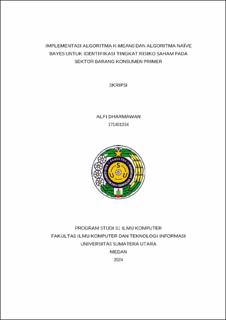Implementasi Algoritma K-Means dan Algoritma Naïve Bayes untuk Identifikasi Tingkat Risiko Saham pada Sektor Barang Konsumen Primer
Implementation of K-Means Algorithm and Naïve Bayes Algorithm for Identification of Stock Risk Level in Primary Consumer Goods Sector

Date
2024Author
Dharmawan, Alfi
Advisor(s)
Rachmawati, Dian
Manik, Fuzy Yustika
Metadata
Show full item recordAbstract
Stocks are investment assets that have high risk high gain characteristics, namely assets that offer high returns but also have a high level of risk. Data from the Indonesia Stock Exchange annual report shows that throughout 2022 there was an increase in the number of public investors in the Indonesian capital market, which includes stocks, mutual funds, and bonds, by 37.68% to 10.31 million Single Investor Identification (SID). In making an investment, investors are faced with two potentials, namely potential profits and losses. The risk of investing can be minimized by choosing company stocks that have good fundamental conditions. This research aims to facilitate investors in filtering groups of stock with good fundamental, especially in the primary consumer goods sector using the K-Means clustering algorithm with K-Means++ optimization and the Naïve Bayes classification algorithm. The study used 82 stock data of primary consumer goods sector companies in the second liner category taken from Stockbit securities and RTI Business applications on February 29, 2024 with 6 financial ratios contained in each of these companies. Based on the system that has been built, it is concluded that the optimal number of k for clustering classes is 3 classes according to the Elbow method, with each class having a low, medium and high risk level. This web-based system is also able to classify 10 stocks in the same sector but not including second liners. With 4 scenarios of training and testing data ratio, the results of system testing on the model that has been built successfully obtained the highest accuracy value of 94.44% with a percentage of 80% for training data and 20% for testing data,while the average accuracy value obtained is 87.12%.
Collections
- Undergraduate Theses [1253]
